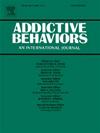计划限制或抑制高风险的酒精消费?通过析因分析和潜在分析,对学生保护行为策略有更深入的了解
IF 3.6
2区 医学
Q1 PSYCHOLOGY, CLINICAL
引用次数: 0
摘要
目的保护性行为策略(PBS)是一种认知行为策略,有望减少学生的危险酒精消费和酗酒(BD)。本研究通过建立一个稳定的PBS类型,评估PBS有效性的变化,以及2)影响PBS使用的心理社会风险因素来调查PBS的多维性质。方法在大学生中进行两项补充性研究(NS1 = 1252;ns2 = 896)。两项研究均检验了PBS的因子结构和性别不变性。研究1采用以变量为中心的方法和多变量回归模型来评估PBS类型、饮酒结果和心理社会决定因素之间的联系。研究2采用了以人为中心的方法,利用潜在特征分析来确定PBS使用者和非使用者的不同特征,以及他们在PBS利用、心理决定因素和酒精相关结果方面的特征。结果首先,两项研究均证实了PBS的四种类型,并表现出性别不变性。其次,某些PBS类型,如饮酒习惯改变(MOD)和计划消费限制(PLD),对危险饮酒行为最具保护作用,但利用率较低。第三,结合所有四种PBS类型的档案显示风险最低,尽管他们只占学生的少数。第四,心理社会因素,特别是饮酒身份,抑制了MOD和PLD的使用。结论:研究结果强调了多维PBS框架的价值。干预措施应针对PBS战略的多样性,并解决社会心理障碍,以促进有效使用,为减少学生过度饮酒提供新的见解。本文章由计算机程序翻译,如有差异,请以英文原文为准。
Planning limits or inhibiting risky alcohol consumption? Towards a deeper understanding of Protective Behavioral Strategies in students through factorial and latent profile analyses
Objective
Protective Behavioral Strategies (PBS) are cognitive-behavioral strategies that are promising to reduce risky alcohol consumption and binge drinking (BD) among students. This research investigates 1) the multidimensional nature of PBS by establishing a stable typology, assessing variations in PBS effectiveness, and 2) psychosocial risk factors influencing PBS use.
Methods
Two complementary studies were conducted among university students (NS1 = 1252; NS2 = 896). In both, factorial structure and gender invariance of PBS were tested. Study 1 used a variable-centered approach with multivariate regression models to assess the links between PBS types, drinking outcomes, and psychosocial determinants. Study 2 applied a person-centered approach, utilizing a latent profile analysis to identify distinct profiles of PBS users and non-users based and their characteristics in terms of PBS utilization, psychological determinants, and alcohol-related outcomes.
Results
Firstly, both studies confirmed the four-type PBS typology and demonstrated gender invariance. Secondly, certain PBS types, such as modification of drinking practices (MOD) and planning consumption limits (PLD), were the most protective against risky drinking behaviors but were the less utilized. Thirdly, profiles combining all four PBS types showed the lowest risk, though they comprise a minority of students. Fourthly, psychosocial determinants, particularly drinking identity, inhibited MOD and PLD use.
Conclusions
Findings highlight the value of a multidimensional PBS framework. Interventions should target diversity in PBS strategies and address psychosocial barriers to promote effective use, offering new insights for reducing excessive drinking among students.
求助全文
通过发布文献求助,成功后即可免费获取论文全文。
去求助
来源期刊

Addictive behaviors
医学-药物滥用
CiteScore
8.40
自引率
4.50%
发文量
283
审稿时长
46 days
期刊介绍:
Addictive Behaviors is an international peer-reviewed journal publishing high quality human research on addictive behaviors and disorders since 1975. The journal accepts submissions of full-length papers and short communications on substance-related addictions such as the abuse of alcohol, drugs and nicotine, and behavioral addictions involving gambling and technology. We primarily publish behavioral and psychosocial research but our articles span the fields of psychology, sociology, psychiatry, epidemiology, social policy, medicine, pharmacology and neuroscience. While theoretical orientations are diverse, the emphasis of the journal is primarily empirical. That is, sound experimental design combined with valid, reliable assessment and evaluation procedures are a requisite for acceptance. However, innovative and empirically oriented case studies that might encourage new lines of inquiry are accepted as well. Studies that clearly contribute to current knowledge of etiology, prevention, social policy or treatment are given priority. Scholarly commentaries on topical issues, systematic reviews, and mini reviews are encouraged. We especially welcome multimedia papers that incorporate video or audio components to better display methodology or findings.
Studies can also be submitted to Addictive Behaviors? companion title, the open access journal Addictive Behaviors Reports, which has a particular interest in ''non-traditional'', innovative and empirically-oriented research such as negative/null data papers, replication studies, case reports on novel treatments, and cross-cultural research.
 求助内容:
求助内容: 应助结果提醒方式:
应助结果提醒方式:


